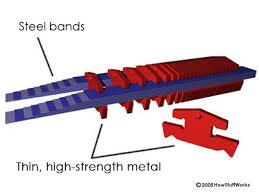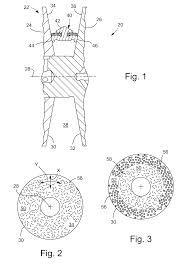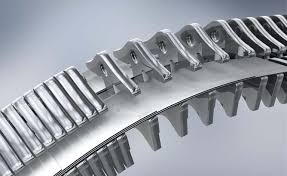CVT - rubber belt or chain
#1
CVT - rubber belt or chain
Would any one know if the 2015 Fit CVT uses a reinforced rubber belt or a chain? Other manufacturers, such as Subaru, advertise widely that they use a chain. Some other CVT's use the term 'steel belt'. Honda description of the CVT just mention 'belt'.
I suspect it is made of reinforced rubber and I would have expected some scheduled preventive replacement. Does the Maintenance Minder give a warning when the belt needs replacement?
I suspect it is made of reinforced rubber and I would have expected some scheduled preventive replacement. Does the Maintenance Minder give a warning when the belt needs replacement?
#2
#4
Ok, I finally found it. It is a metal belt.
Temple of VTEC Rumors and News - The complete story about the new Honda CVT transmission
In simple terms, CVT consists of a drive pulley (input) and a driven pulley (output) connected by a steel belt, which transmit torque from the engine to the final drive. The steel belt is a ring of numerous steel element plates that are joined with two-layered ring bundles. One side of each pulley is fixed, while the other side can be hydraulically moved in and out, in effect altering the diameter of each pulley; those changes in pulley diameter are synchronised and as a result the belt rides lower or higher on the walls of each pulley to provide continuously variable changes to the gearing of the car. CVT therefore does not change gear in a series of steps, but instead delivers smooth, seamless performance from standstill to full speed operation.
Interesting this is the article is dated 2002! Yet it talks about the Honda Jazz CVT. 8-/
Temple of VTEC Rumors and News - The complete story about the new Honda CVT transmission
In simple terms, CVT consists of a drive pulley (input) and a driven pulley (output) connected by a steel belt, which transmit torque from the engine to the final drive. The steel belt is a ring of numerous steel element plates that are joined with two-layered ring bundles. One side of each pulley is fixed, while the other side can be hydraulically moved in and out, in effect altering the diameter of each pulley; those changes in pulley diameter are synchronised and as a result the belt rides lower or higher on the walls of each pulley to provide continuously variable changes to the gearing of the car. CVT therefore does not change gear in a series of steps, but instead delivers smooth, seamless performance from standstill to full speed operation.
Interesting this is the article is dated 2002! Yet it talks about the Honda Jazz CVT. 8-/
Last edited by tmfit; 08-19-2014 at 02:19 PM.
#5
Ok, I finally found it. It is a metal belt.
Temple of VTEC Rumors and News - The complete story about the new Honda CVT transmission
Interesting this article is dated 2002! Yet it talks about the Honda Jazz CVT. 8-/
Temple of VTEC Rumors and News - The complete story about the new Honda CVT transmission
Interesting this article is dated 2002! Yet it talks about the Honda Jazz CVT. 8-/
#6
my guess would be yes, rubber is not an option to run in an oil bath and I'm not sure carbonfiber could take the constant flex.
#7
Every automotive CVT I'm aware of (which isn't saying all that much) uses some sort of a metal drive element, whether a chain or a cable of some sort. Well, at least every CVT of at all recent origin, ignoring things like the Tucker that were essentially a variable torque converter.
#9
The CVT belt is metal, and it is an interesting design as the power is transmitted via pushing rather than pulling as in a conventional rubber belt!
The belt consists of a loop of thin metal on which are mounted hundreds of thin plates, each in the cross-section of the belt. The makes the belt flexible enough to fit around the sheaves of the pulleys.
When leaving the drive pulley, the belt elements stack to form a solid column of plates that connect the drive pulley to the driven pulley. This eliminates flexing and slippage in the driven element.
The belt consists of a loop of thin metal on which are mounted hundreds of thin plates, each in the cross-section of the belt. The makes the belt flexible enough to fit around the sheaves of the pulleys.
When leaving the drive pulley, the belt elements stack to form a solid column of plates that connect the drive pulley to the driven pulley. This eliminates flexing and slippage in the driven element.
#10
Ok, I finally found it. It is a metal belt.
Temple of VTEC Rumors and News - The complete story about the new Honda CVT transmission
In simple terms, CVT consists of a drive pulley (input) and a driven pulley (output) connected by a steel belt, which transmit torque from the engine to the final drive. The steel belt is a ring of numerous steel element plates that are joined with two-layered ring bundles. One side of each pulley is fixed, while the other side can be hydraulically moved in and out, in effect altering the diameter of each pulley; those changes in pulley diameter are synchronised and as a result the belt rides lower or higher on the walls of each pulley to provide continuously variable changes to the gearing of the car. CVT therefore does not change gear in a series of steps, but instead delivers smooth, seamless performance from standstill to full speed operation.
Interesting this is the article is dated 2002! Yet it talks about the Honda Jazz CVT. 8-/
Temple of VTEC Rumors and News - The complete story about the new Honda CVT transmission
In simple terms, CVT consists of a drive pulley (input) and a driven pulley (output) connected by a steel belt, which transmit torque from the engine to the final drive. The steel belt is a ring of numerous steel element plates that are joined with two-layered ring bundles. One side of each pulley is fixed, while the other side can be hydraulically moved in and out, in effect altering the diameter of each pulley; those changes in pulley diameter are synchronised and as a result the belt rides lower or higher on the walls of each pulley to provide continuously variable changes to the gearing of the car. CVT therefore does not change gear in a series of steps, but instead delivers smooth, seamless performance from standstill to full speed operation.
Interesting this is the article is dated 2002! Yet it talks about the Honda Jazz CVT. 8-/
That CVT was very different to the current one, it used a clutch to disengage the transmission while the new one uses a torque converter.
Last edited by gusvera; 02-12-2015 at 10:31 AM.
#11
The CVT belt is metal, and it is an interesting design as the power is transmitted via pushing rather than pulling as in a conventional rubber belt!
The belt consists of a loop of thin metal on which are mounted hundreds of thin plates, each in the cross-section of the belt. The makes the belt flexible enough to fit around the sheaves of the pulleys.
When leaving the drive pulley, the belt elements stack to form a solid column of plates that connect the drive pulley to the driven pulley. This eliminates flexing and slippage in the driven element.
The belt consists of a loop of thin metal on which are mounted hundreds of thin plates, each in the cross-section of the belt. The makes the belt flexible enough to fit around the sheaves of the pulleys.
When leaving the drive pulley, the belt elements stack to form a solid column of plates that connect the drive pulley to the driven pulley. This eliminates flexing and slippage in the driven element.
Last edited by nomenclator; 10-05-2015 at 11:37 AM.
#12
Right, but how does having a "solid column of plates" connecting the drive pulley to the driven pulley serve to elimnate slippage in the driven pulley? And what prevents the drive pulley from slipping? I know nothing about the surface of the pulleys. What enables the stack of plates to move the pulleys? As far as I know, there are no gear teeth, only friction. To measure friction, you have to know about the coefficient of friction for the 2 materials in contact, and about the about of force pushing them 2 materials toward each other. How the plates "grab" onto the pulley is a complete mystery which this description of "stacking" didn't nothing to elucidate. You generally want a belt to flex because this keeps more of the belt in contact with the (circular diameter of the) pulley and thus adequate friction is applied with less downward force needed. Less downward force means less stretching of the belt and less stress on the pulley bearings.
As far as I get it, the pulleys surface have an engineered roughness, with laser etched microgroovers, the CVT fluid is designed to indrease the friction between the belt and pulley and the electronics constantly adapt the pulleys to get exactly the belt tension needed for the required torque needs.
When GeorgL wrote about eliminating flex, that wasn't when the belt is around the pulley, it's when it's pushing between the pulleys, these CVT do push the belt, not pull, the 'shims' stack together and form a 'solid bar' as they are pushed. Look at the photos below and you'll get the idea.




Last edited by gusvera; 10-05-2015 at 12:59 PM.
#13
Thanks Gusvera. Good information.
I haven't been able to find any other info about the nature of the contact surface of the pulleys. I can't see the middle drawing very well. Could you tell me where you found that drawing of the pulleys? I've seen representations of the belt before, but not the surface of the pulleys.
So it seems like the gist of what enables the drive pulley to keep pushing the driven pulley without slippage might be that the computer-controlled stepper motor that pushes half of each pulley inward or outward to change its rotational diameter, and thus the "gear" ratio, could also push the pulley-halves of each pulley inward a little further if the belt starts to slip, until the slipping stops. The implies there must be some sensor that allows the computer to know if slippage is occurring. I suppose a momentary loss of rotational motion could easily be picked up by some kind of sensor that senses some kind of marking along a circumference of the pulley. But this is all just conjecture.
Regarding the "engineered microgrooves" - one might think they would wear away after not too long. I can see that there would be challenges in designing a system using a chain and sprockets or gear-teeth. Offhand I don't know any way of continuously varying the diameter of the kind of gear that is turned by a chain, but I know that v-shaped pulleys that get smaller or larger in diameter as their halves are pulled apart or pushed together have been used with belts for a long time - rubberized fabric belts.
I haven't been able to find any other info about the nature of the contact surface of the pulleys. I can't see the middle drawing very well. Could you tell me where you found that drawing of the pulleys? I've seen representations of the belt before, but not the surface of the pulleys.
So it seems like the gist of what enables the drive pulley to keep pushing the driven pulley without slippage might be that the computer-controlled stepper motor that pushes half of each pulley inward or outward to change its rotational diameter, and thus the "gear" ratio, could also push the pulley-halves of each pulley inward a little further if the belt starts to slip, until the slipping stops. The implies there must be some sensor that allows the computer to know if slippage is occurring. I suppose a momentary loss of rotational motion could easily be picked up by some kind of sensor that senses some kind of marking along a circumference of the pulley. But this is all just conjecture.
Regarding the "engineered microgrooves" - one might think they would wear away after not too long. I can see that there would be challenges in designing a system using a chain and sprockets or gear-teeth. Offhand I don't know any way of continuously varying the diameter of the kind of gear that is turned by a chain, but I know that v-shaped pulleys that get smaller or larger in diameter as their halves are pulled apart or pushed together have been used with belts for a long time - rubberized fabric belts.
#14
The second drawing is from US patent # US20120088615, just google it.
In particular, this patent suggests a diferent pattern in the outer part of the pulley.
An interesting CVT is the one in the Prius:
http://eahart.com/prius/psd/
Regards
In particular, this patent suggests a diferent pattern in the outer part of the pulley.
An interesting CVT is the one in the Prius:
http://eahart.com/prius/psd/
Regards
Last edited by gusvera; 10-05-2015 at 03:20 PM.
#15
Thread
Thread Starter
Forum
Replies
Last Post
Namae Kana
3rd Generation (2015+)
3
07-10-2015 09:54 AM
SheepNutz
3rd Generation (2015+)
14
08-20-2014 09:52 AM
hazzard
Fit Engine Modifications, Motor Swaps, ECU Tuning
8
11-20-2013 01:38 AM




